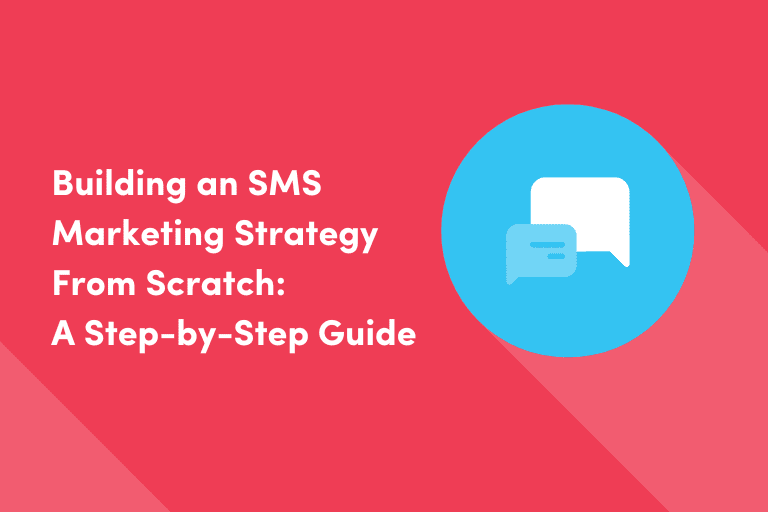At the bake sale, which table are you buying from: the one with the scratch-made cookies or the ones that came pre-perforated? Different question: when you have to make cookies for the bake sale, which are you choosing to make?
Yes, building something from scratch takes more effort, but we also know the effort can pay off in the long run. This is true for both cookies and building an SMS marketing strategy.
SMS marketing has solidified its position as a powerful tool for businesses, offering a direct and immediate way to connect with customers. If you’re new to SMS marketing or looking to integrate it into your existing cross-channel strategy, this guide will walk you through the essentials of building an SMS marketing strategy from scratch.
Why SMS Marketing?
Before diving into the how, let’s explore the why. SMS marketing boasts impressive open rates, often as high as 98%, with most messages—90%—being read within three minutes of receipt. It provides a personal, direct line to your audience, cutting through the noise of crowded email inboxes and social media feeds. When done right, SMS marketing can drive engagement, boost conversions, and build stronger customer relationships.
Now that you know why SMS marketing is important, let’s explore the steps every brand should take when embarking on developing an effective SMS marketing strategy.
Step 1: Define Your Goals and Objectives
As with any marketing endeavor, the first step is to define what you want to achieve. Are you looking to drive sales, increase engagement, promote a new product, or enhance customer service? Clear objectives will guide your strategy and help measure success.
- Specificity: Make your goals specific and measurable. Instead of a vague goal like “increase sales,” aim for “increase sales by 20% over the next quarter through SMS campaigns.”
- Relevance: Ensure your goals align with your overall business objectives and marketing strategy.
Step 2: Understand Compliance and Regulations
Navigating the regulatory landscape is crucial to avoid legal pitfalls. Familiarize yourself with laws such as the Telephone Consumer Protection Act (TCPA) in the US and General Data Protection Regulation (GDPR) in the EU.
- Consent: Obtain explicit opt-in consent from recipients before sending messages. This can be done through opt-in forms on your website or during checkout.
- Clear Opt-Out: Provide an easy way for recipients to unsubscribe from your messages, typically by replying “STOP.”
Step 3: Build Your SMS Subscriber List
A robust subscriber list is the backbone of your SMS marketing strategy. Start by leveraging your existing channels to encourage sign-ups.
- Website Integration: Add SMS opt-in forms to your website, making it easy for visitors to subscribe. Use enticing offers like discounts or exclusive content to incentivize sign-ups.
- Social Media: Promote your SMS program on social platforms with clear calls-to-action and compelling reasons to join.
- Email Campaigns: Include SMS sign-up options in your email newsletters to convert existing subscribers into SMS contacts.
Step 4: Choose the Right SMS Marketing Platform
Selecting the right platform is crucial for managing your campaigns effectively. Look for a platform that offers robust features, such as segmentation, automation, and analytics.
- Integration: Ensure the platform integrates seamlessly with your existing tools and CRM systems.
- User Experience: Choose a user-friendly platform that simplifies the process of creating and managing campaigns.
- Cross-Channel Capabilities: Rather than adding a siloed SMS tool, explore the capabilities and added benefits of using your existing cross-channel marketing platform.
Step 5: Segment Your Audience
Segmentation allows you to send targeted messages that resonate with specific groups within your audience, leading to higher engagement and conversion rates.
- Demographics: Segment your audience based on age, gender, location, and other demographic factors.
- Behavioral Data: Use purchase history, browsing behavior, and engagement metrics to create tailored segments.
Step 6: Craft Compelling Messages
Your messages should be concise, engaging, and aligned with your brand voice. Given the 160-character limit for SMS, every word counts.
- Personalization: Use the recipient’s name and tailor the content to their preferences or past behaviors.
- Call-to-Action (CTA): Include a clear and compelling CTA, such as “Shop Now,” “Learn More,” or “Claim Your Discount.”
- Timing: Send messages at optimal times to maximize engagement. Avoid sending messages too early in the morning or too late at night.
Step 7: Automate and Optimize
Automation can save time and ensure timely delivery of messages. Set up automated workflows for various scenarios, such as:
- Welcome Messages: Send a warm welcome message to new subscribers.
- Transactional Messages: Provide order confirmations, shipping updates, or appointment reminders.
- Promotional Campaigns: Schedule messages for sales events, special offers, or new product launches.
Step 8: Monitor and Analyze Performance
Tracking your campaign performance is essential to understand what’s working and what needs improvement. Key metrics to monitor include:
- Open Rate: Although almost all SMS messages are opened, tracking this can help identify any delivery issues.
- Click-Through Rate (CTR): Measure the effectiveness of your CTAs by tracking how many recipients click on the links in your messages.
- Conversion Rate: Evaluate how many recipients take the desired action, such as making a purchase or signing up for a webinar.
Use this data to refine your strategy, optimize your messages, and improve overall performance.
Step 9: Integrate SMS with Your Cross-Channel Strategy
To maximize the impact of your SMS marketing, integrate it with your broader marketing strategy. Use SMS to complement other channels, creating a cohesive and seamless customer experience.
- Cross-Promotions: Promote your SMS list through email, social media, and even offline channels like in-store signage.
- Consistent Messaging: Ensure your messaging is consistent across all channels, reinforcing your brand and amplifying your campaigns.
Keeping track of individual customer preferences can help ensure you’re sending SMS messages to those who want them, and using other channels with those who may not.
Step 10: Continuously Iterate and Improve
Customer preferences are constantly evolving, and your SMS marketing strategy should evolve with it. Regularly review your campaigns, gather feedback, and experiment with new approaches.
- A/B Testing: Test different message formats, CTAs, and sending times to identify what works best for your audience.
- Stay Updated: Keep abreast of new trends and technologies in SMS marketing to stay competitive.
It’s Worth the Effort
Building a successful SMS marketing strategy from scratch requires careful planning, creativity, and a commitment to continuous improvement. By defining clear goals, understanding regulations, and leveraging the power of segmentation and automation, you can create compelling SMS campaigns that drive results and enhance your overall marketing efforts. Integrate SMS into your cross-channel strategy to deliver a seamless and engaging customer experience, and watch your brand thrive in the competitive digital landscape.
Ready to kickstart your SMS marketing journey? Dive in, experiment, and unlock the full potential of SMS to connect with your audience like never before. Schedule an Iterable demo today.

































